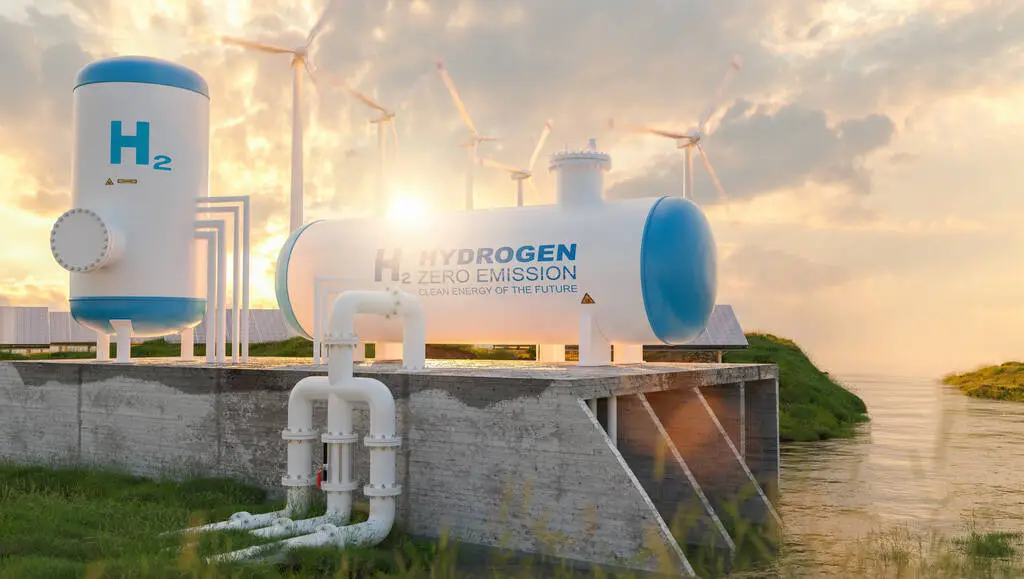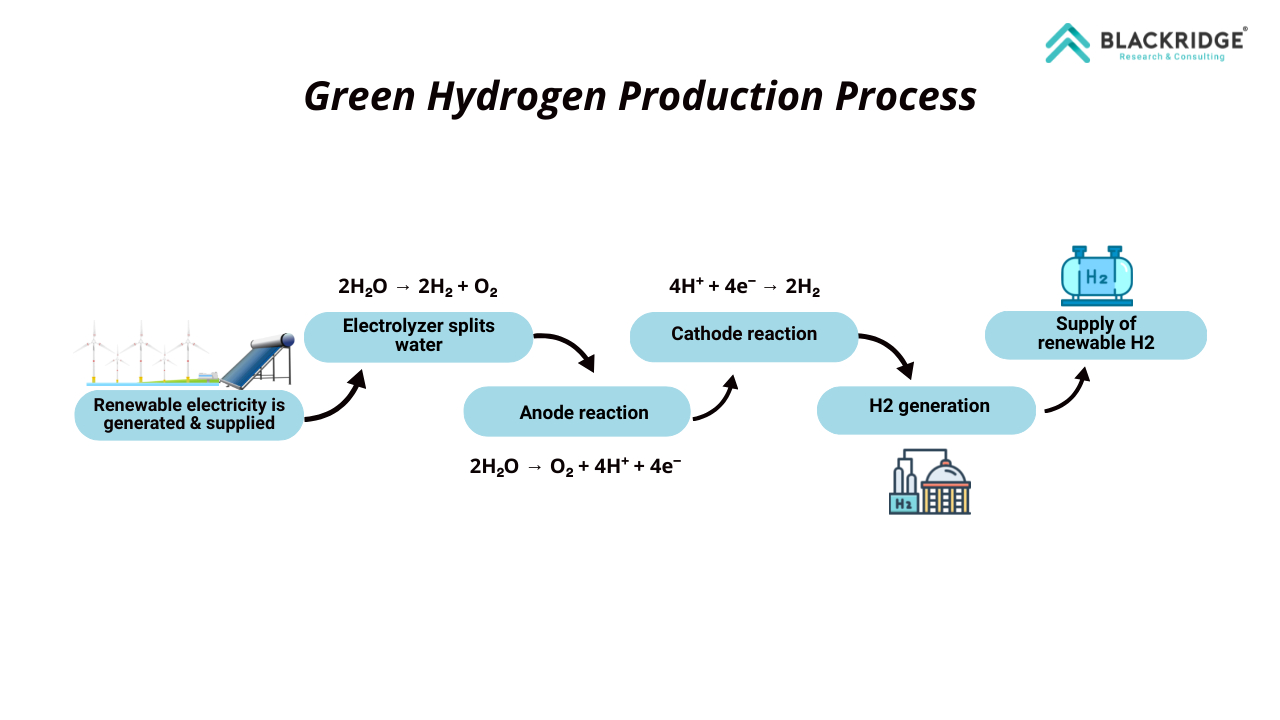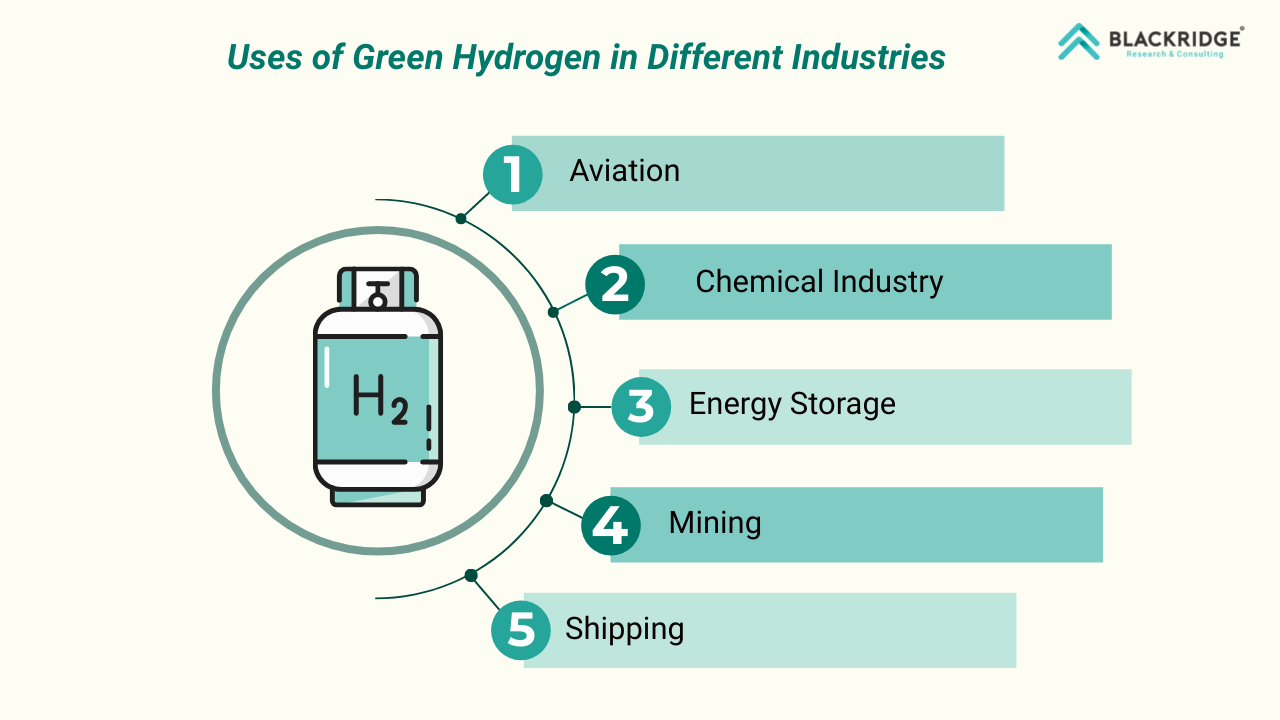Table of Contents
Green hydrogen is produced by the electrolysis of water using renewable energy sources like solar, wind, or hydroelectric energy. Green hydrogen has significantly lower carbon emissions.

This is in contrast to grey hydrogen which is produced using fossil fuels, such as natural gas or coal, through a process called steam methane reforming (SMR). This method releases large amounts of carbon dioxide into the atmosphere, contributing to climate change and other environmental problems.
To create green hydrogen, electricity from renewable sources is used to power an electrolyzer, which splits water molecules into hydrogen and oxygen. The resulting hydrogen gas is then captured and stored for later use as a clean energy source.
Green hydrogen is considered a promising solution for reducing carbon emissions in industries such as transportation, energy generation, and manufacturing. Since it is produced using renewable energy sources, it has the potential to significantly reduce greenhouse gas emissions and mitigate climate change.
In recent years, green hydrogen has gained significant traction in the world’s interest and investment in newer fuel forms. Some of the key drivers of the green hydrogen industry growth include growing renewable energy capacity additions, rapidly growing low-carbon projects, increasing adoption of fuel cell electric vehicles (FCEVs), extensive hydrogen R&D, supportive government policies and regulations, and government and private energy investment boom.
Why is the Demand for Hydrogen Rising?
Hydrogen can be the best fuel alternative for transportation and electricity generation because it is potentially carbon-free. Also, it emits only water vapor when consumed in a fuel cell.
Another major advantage of hydrogen is it can function as an energy carrier, capable of storing, transporting, and delivering energy derived from other sources. The industrial sector, liquid fuels, heat generation, energy storage, and transportation are some of the emerging applications for hydrogen.
However, the major obstacle to realizing a hydrogen economy is the energy-intensive nature of its production methods. Both steam reformation of methane and electrolysis, the two industrial methods of production, requires more energy than the hydrogen they generate.
The global hydrogen demand has been on the rise for the past few decades. As per the Blackridge's global hydrogen market report the global hydrogen demand is expected to be 150 Mt (Metric tonnes) by 2030. The reason for the rising hydrogen demand and consumption can be attributed to the abundance and high energy density of hydrogen. Also, hydrogen is a clean fuel that emits little emissions when used as a fuel.
Abundance of Hydrogen
Hydrogen is the most abundant element in the universe, making up about 75% of its elemental mass. It can be found in a wide range of sources, including water, natural gas, and biomass.
High Energy Density of Hydrogen
Hydrogen has a high energy density per unit of weight, making it an efficient energy carrier. It also has the potential to be produced using any source of energy including renewable energy sources, such as solar or wind power. This makes hydrogen a sustainable energy option.
Clean fuel
Hydrogen produces no emissions when used as a fuel, only producing water vapor and heat. This makes it an attractive alternative to fossil fuels which produce harmful greenhouse gases and contribute to climate change.
Why we Need Green Hydrogen?
Supplying hydrogen to industrial users is now a major business around the world. Demand for hydrogen, which has grown more than threefold since 1975, continues to rise – almost entirely supplied by fossil fuels, with 6% of global natural gas and 2% of global coal going to hydrogen production.
As a consequence, the production of hydrogen is responsible for CO2 emissions of around 830 million tonnes of carbon dioxide per year, equivalent to the CO2 emissions of the United Kingdom and Indonesia combined.
Here are the reasons how green hydrogen can mitigate emission worries:
Renewable and Sustainable: The production of green hydrogen uses renewable energy sources such as solar, wind, and hydroelectric power, making it a sustainable and environmentally friendly alternative to conventional hydrogen production methods that rely on fossil fuels. The use of a renewable source of energy reduces greenhouse gas emissions and mitigates the impact of climate change.
Energy Storage: Hydrogen can be stored and transported, making it an excellent energy storage solution. It can be used as a fuel for vehicles, and it can also be used to power electricity generators or fuel cells, making it a versatile energy carrier.
Decarbonization: Green hydrogen can play a crucial role in decarbonizing industries that are currently reliant on fossil fuels, such as transportation, industry, and heating. It can also be used to generate renewable electricity, replacing fossil fuels in power generation.
Economic Benefits: The production and use of green hydrogen can create new economic opportunities, such as job creation, investment in renewable energy infrastructure, and the development of new technology.
International Cooperation: Green hydrogen can provide an opportunity for international cooperation, as countries with abundant renewable energy resources can produce green hydrogen and export it to other countries that have less access to renewable energy. This can create new economic and political ties between nations and promote global energy security.
Green Hydrogen vs. Other Types of Hydrogen
Never again will you think of hydrogen as just a colorless gas—thanks to an envious hydrogen taxonomy rainbow formed due to diverse production methods.
Different types of hydrogen include blue hydrogen, brown hydrogen, green hydrogen, grey/gray hydrogen, pink/purple/red hydrogen, turquoise hydrogen, yellow hydrogen, and white hydrogen.
Hydrogen is a versatile energy carrier. The rationale behind producing green hydrogen is to replace grey hydrogen derived from natural gas rather than a renewable energy source. The bulk of the hydrogen market consists of the least renewable grey hydrogen that is produced from fossil fuels.
Green Hydrogen vs. Blue Hydrogen
While water is the building block of green hydrogen, natural gas is necessary for blue hydrogen that is produced by steam methane reforming (SMR) or auto thermal reforming (ATR) to form hydrogen and carbon dioxide. The released CO2 is captured and stored—resulting in a low environmental impact. Blue hydrogen is an output of natural gas production that mixes natural gas with very hot steam and a catalyst.
Read: Difference between blue hydrogen vs green hydrogen
Green Hydrogen vs. Grey Hydrogen
Grey or gray hydrogen is the most widely produced type of hydrogen made from fossil fuels. However, the amount of carbon waste released into the atmosphere during the production process makes it an environmentally hazardous fuel. On the other hand, electrolysis-derived green hydrogen is an environmentally friendly fuel with no unhealthy emissions.
While grey hydrogen produces CO2 as a byproduct and blue hydrogen capture and stores most of the CO2 output during hydrogen production using a gasifier or reformer, green hydrogen’s byproduct is oxygen.
How is Green Hydrogen Produced?
Green hydrogen is produced through a process called electrolysis, which involves using an electric current to split water molecules (H2O) into their constituent elements, hydrogen (H2) and oxygen (O2). Here is a detailed step-by-step process of how green hydrogen is produced:
- Water is first purified and fed into an electrolysis cell, which consists of two electrodes (an anode and a cathode) separated by a membrane.
- An electric current is applied to the electrodes, causing water molecules to split into hydrogen ions (H+) and hydroxide ions (OH-).
- The hydrogen ions are attracted to the cathode, where they combine with electrons (e-) from the electric current to form hydrogen gas (H2). The hydroxide ions migrate to the anode, where they combine with electrons to form oxygen gas (O2).
- The hydrogen gas is then collected, compressed, and stored in tanks for use in a variety of applications, such as fuel cells, transportation, and industrial processes.
- The oxygen gas produced in the process is typically released into the atmosphere.

The above process describes how green hydrogen is produced using renewable electricity, such as solar or wind power, which is free of greenhouse gas emissions. This makes green hydrogen a clean and sustainable energy source, with the potential to replace fossil fuels in a variety of applications.
Find Latest Green Hydrogen Projects Across the Globe. Claim Your Free Leads Now!
Uses of Green Hydrogen in Different Industries
Apart from using hydrogen to fuel vehicles (two-wheelers, three-wheelers, cars, buses, etc.), green hydrogen can also be used across a broad range of industries. Let’s take a look at its use cases in different industries

Aviation
Green hydrogen jet fuel is yet to realize its full potential due to hydrogen’s energy density. As hydrogen-powered aircraft require bigger fuel tanks than their conventionally-fueled counterparts to travel the same distance, long-range flights are a possibility—not a reality as of now.
Chemical Industry
Ammonia (NH3) is widely used for agricultural fertilizer production. Unlike conventional ammonia which uses natural gas as feedstock and contributes to greenhouse gas, green ammonia is made by combining green hydrogen with nitrogen from the air.
Green Methanol
Methanol mainly serves as a base for different chemical products, such as adhesives, paints, plastics for packaging, polymer fibers for the textile industry, solvents, etc. The ongoing decarbonization efforts have redefined the CO2-heavy production of methanol that uses fossil feedstock.
The future-fit ThyssenKrupp’s green methanol technology (Uhde Methanol technology) produces hydrogen by the alkaline water electrolysis (AWE) process to make environmentally friendly methanol suitable for industrial-scale plants.
Energy Storage
Green hydrogen is an ideal energy storage carrier to maintain grid reliability and stabilize the load. Be it bulk, multi-day, or seasonal energy storage—green hydrogen can be stored to meet daily demand fluctuations and correct short-load mismatches. It is believed that hydrogen used as a bulk energy storage solution or a multi-day storage resource is cost-effective compared to batteries to meet total world annual energy demand.
Also Read: An Essential Guide to Battery Energy Storage System (BESS)
Heating (Residential and Commercial)
Green hydrogen is quite useful for heat generation in residential and commercial buildings. Green hydrogen can supply 100% of the heating fuel or blend with natural gas pipelines as an alternative to heating with oil or natural gas. Operational resiliency and uninterrupted service are key advantages of using on-site hydrogen fuel cells to provide heat and electricity to buildings.
Mining
Using green hydrogen is a great way to decarbonize mining operations and remote area power systems (RAPS). RAPS often rely on diesel fuel to generate power and operate mining equipment. Green hydrogen is well suited to reduce operational costs and health risks and power up trucks and heavy equipment at mining sites.
Power Generation
There are two main mechanisms for use of green hydrogen to provide on-demand dispatchable renewable electricity: The Power-Gas-Power method combusts hydrogen fuel in a gas turbine; on the other hand, a fuel cell generates combustion-free electricity.
As more low-cost renewable (wind and solar) energy is interconnected to the grid, utility-scale power generation using green hydrogen is economic and reliable. Furthermore, it avoids the wasteful curtailment of renewable energy sources.
Refineries
Large-scale electrolyzers located at refineries are crucial for petrochemical refining. Electrolyzers produce green hydrogen that is used to lower the sulfur content of crude oil (desulfurization of crude oil) to make diesel, petrol, etc.
Shipping
Green hydrogen tech interventions hope to replace ammonia made from natural gas with green ammonia for ships. Decarbonizing the shipping sector will be instrumental in reducing greenhouse gas emissions and minimizing the environmental impact. As promising as it sounds, the question is: Is this completely feasible? Not yet.
Steel Manufacturing
Steel manufacturing uses fossil fuels, such as coal, oil, and natural gas at high temperatures. The energy-hungry process accounts for approximately 7% of all CO2 emissions. Decarbonizing the steel sector with green hydrogen paves the way for making “green steel” with the lowest carbon footprint currently possible and recycling steel in a fully electric process with a minimal environmental impact.
Transport
Recent R&D efforts have successfully demonstrated smart technology-driven mobility solutions that showcase how green hydrogen is used as a fuel for fuel cell electric vehicles.
A hydrogen fuel cell is an electrochemical cell that generates electricity by converting the chemical energy of a fuel and an oxidizing agent via redox reactions.
Unlike a gasoline station, a hydrogen fueling station (HRS) is a facility for storing or filling hydrogen. While an internal combustion engine emits a greenhouse gas in large quantities, a hydrogen fuel cell electric vehicle emits fewer pollutants.
Limitations of Green Hydrogen
Cost
The cost of green or clean hydrogen production is still relatively high compared to conventional hydrogen production methods, such as steam methane reforming. While the cost of renewable energy is decreasing, further cost reductions are needed to make green hydrogen more competitive.
Infrastructure
The infrastructure for storing, transporting, and distributing hydrogen is currently limited, which makes it difficult to scale up the use of green hydrogen in various industries.
Efficiency
The process of electrolyzing water to produce hydrogen is not very efficient, with a significant amount of energy lost during the process. Improving the efficiency of electrolyzers is critical to reducing the cost of green hydrogen production.
Safety
Hydrogen is highly flammable and requires careful handling to ensure safety. While hydrogen can be safely handled, there are still safety concerns associated with its use, which need to be addressed.
Scalability
The current production capacity of green hydrogen is limited, and scaling up production to meet demand will require significant investments in infrastructure and technology.
Global Green Hydrogen Market
The global green hydrogen market is witnessing a growth in line with the carbon neutrality goals 2030. About 590 GW of cummulative installed electrolyzer capacity is targeted for 2030. Likewise cummulative hydrogen pipelines of 19,000 km long and an underground hydrogen storage capacity of 70 Twh (Terrawatt hour) is expected by 2030. Get deeper insights on the global green hydrogen market. China, US, India and many other countries have introduced government policies supporting the green hydrogen deployment.
Find Latest Green Hydrogen Projects Across the Globe. Claim Your Free Leads Now!
Top Green Hydrogen Companies in the world
Check out the complete list of the Top 10 Green Hydrogen Companies in the World.
Read: Top 7 Green Hydrogen Companies in India
Wrapping Up
The energy landscape is evolving rapidly as the world is advancing towards a green hydrogen economy. There is an urgent need to replace fossil fuels with clean fuels powered by renewable energy sources. Conventional fuels pose significant risks to the environment. The hydrogen economy represents the potential of green hydrogen to tackle decarbonization challenges and provide sustainable energy savings.
As a pollution-free fuel, green hydrogen is certainly a sustainable alternative to phase out fossil fuel usage. However, given the ongoing development and deployment efforts, it will be a while before green hydrogen is available at a commercial scale and at a competitive cost.
Looking to enter Global Green Hydrogen market? Gain direct access to the people driving global energy transition.
Subscribe to our Global Green Hydrogen project database and unlock:
- Comprehensive project details on both upcoming and planned initiatives
- Timely updates on tenders and new developments
- Access to key stakeholders and decision-makers
- Market insights and future trend analysis by experts
Tap into Global green hydrogen projects and drive your business forward!



Leave a Comment
We love hearing from our readers and value your feedback. If you have any questions or comments about our content, feel free to leave a comment below.
We read every comment and do our best to respond to them all.